How to grow tomatoes? Introduction to the precautions and skills of planting Tomato blackened at the bottom
How do tomatoes grow? Why does the bottom of a tomato turn black? What are the planting precautions and techniques? Want to know? Let's take a look together!
Tomato planting methods
Tomatoes, which are also vegetables and fruits, are favorite fruits and vegetables of many people. There are many varieties of tomatoes. In this simple distinction, large fruits and small fruits (saint tomatoes) can be planted all year round. The peak period is between autumn and late spring.
Tomato is suitable for loam or clay soil cultivation, should first seedling, seed germination about 3-5 days after sowing, seedlings about 10-15 cm high can be seedlings.
Tomatoes need a lot of fertilizer. It is best to use more than 10-inch pots for planting, one plant per pot, and fertilize once a week.
The main stem is easy to be blown down by wind when it is 30 cm to 60 cm high. It needs to be supported. Water management needs to pay attention to drainage problems. It cannot be watered for a long time. When the soil is slightly dry, it can be watered. The adult plant is about 1-2 meters high. After flowering, the common problem is that it is not easy to bear fruit. It is recommended to order flowers once you see them bloom (artificial pollination). The sample production capacity will increase greatly. Continuous weekly fertilization can prolong the production period. Tomatoes can generally be harvested in the second stage. If properly managed, they can produce as scheduled.
Tomato diseases and insect pests are quite a lot. Under the principle of not spraying pesticides, first of all, pay attention to avoiding continuous cropping of tomatoes. After planting tomatoes for the second time on the same piece of land, there will be more diseases and insect pests than when planting tomatoes for the first time. Moreover, proper water management can also prevent or reduce the occurrence of diseases and insect pests.
Why does the bottom of a tomato turn black?
1. Tomato bottom blackening is fruit top rot (also known as umbilical rot), which is a phenomenon of calcium deficiency.
2. Can spray 200 times calcium chloride, serious spray once every 3 days, continuous spray 2~3 times.
3. Apply too much nitrogen fertilizer so as not to interfere with calcium absorption.
4. Organic fertilizer with high calcium content can be applied before soil preparation.
Planting Notes and Techniques
Generally, the most suitable light range for tomatoes is 50-80klux. Tomatoes are warm, and the suitable temperature for results is 19-24℃. When the temperature is too high, especially at night, it is easy to cause serious flower drop phenomenon, resulting in poor results, or even incomplete results or smaller fruits. When the temperature is too low, the fertility is slow and there is no resistance to frost damage.
The optimum temperature for the development of red lycopene in tomato fruit is about 19-24℃. When the temperature exceeds 30℃, it is stunted, the fruit is poorly colored, not red but orange yellow.
The length of sunshine has no significant relationship with flower bud differentiation of tomato, but the intensity of illumination has influence on flower bud development. When the intensity of illumination is low, it is easy to cause excessive growth, flower drop, disease and fruit hypertrophy.
The climate conditions are warm with large temperature difference between day and night, drought, little rainfall or no rain, low humidity (relative humidity 30-50%) and sufficient sunshine.
Greenhouse management is very important, if there is a water wall to pay attention to, to avoid the water wall flow is too large, spray out to cause ponding, easy to lead to plant diseases.

- Prev

Litchi pruning technology: how to trim litchi is better? How do you control winter growth?
Litchi planting technology: Litchi's basic tree frame pruning is what kind of, how to trim better? If you don't want to know, let's take a look together! Litchi tree frame is composed of trunk, main branch, sub-main branch and lateral branch. The trunk is off the ground.
- Next

What are the characteristics and uses of bayberry? Red bayberry seeds have been planted for several years before they bear fruit.
The producing area of Taiwan red bayberry is mainly planted in the low-altitude slopes in the middle and north of Taiwan, and the yield period is mostly around Ching Ming Festival in spring. There are many varieties of bayberry, the main cultivated varieties are wild bayberry, button bayberry, red bayberry, pink bayberry, snow bayberry, black bayberry. Do you know how the bayberry tree
Related
- The first cup of black tea in spring, the flavor and history of tea gardens in Kenya, Africa
- The computer can not only choose potatoes, but also grow tea rice. AI will grow winter oolong tea champion.
- It is not only the inflated tea bitten by insects, but also engraved with the four seasons tea in Beipu.
- The Oriental Beauty Tea Festival in Zhuxian County takes the stage at the weekend to experience the plus-size feast of oil tea.
- & quot; Oriental Beauty Tea & Exploration of Emei in Hsinchu, the hometown of quot;
- The new variety of strawberry "Tainong 1" dessert is the first choice with mellow aroma. Crimson gorgeous
- History of Tea in Taiwan: from Wild Inner Mountain to Export Tea Garden
- Two types of Taiwan Oriental Beauty Black Tea won the British three-Star Award for Childhood Tea Xiang Zhang Jiaqi changed from pilot to champion tea maker.
- Banana species and varieties: the planting history of Taiwan Xianren banana and dwarf banana is long, is banana disease resistant?
- Coffee planting Technology: Qianjie Coffee from Seedling to harvesting

